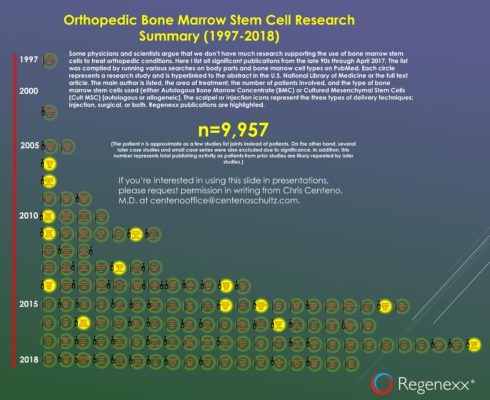My 2018 Bone Marrow Orthopedic Stem Cell Infographic
Every year for the last five or so, I have created an orthopedic stem cell research infographic. This is my 2018 edition, and I’m happy to report that there has been big progress since last year! There are also some interesting research trends to report.
(Click here for a larger view)
Why Do This?
This document is a labor of love. I usually get it done every April but didn’t get to it this year. A colleague pinged me recently about needing a research summary, so that was just enough to light a fire and force me to get it done. This document is also fun for me as it allows me to get up to date on new clinical research I may have snoozed.
Summarizing the Trends
So what did I notice since last year? One of the big trends was the back and forth on the use of bone marrow concentrate (BMC) for hip osteonecrosis. This awful disease is when the hip bone turns to mush and collapses, often leaving the patient with a square peg in a round hole.
What was fascinating this past year are publications where surgeons have been testing core decompression with and without BMC. There doesn’t seem to be a difference, but the surgeons seem to be missing the point. As Hernigou has demonstrated in many studies, just an injection of BMC is enough to cure the right type of hip osteonecrosis patients (ARCO grade 1 and 2). Hence, the surgery part is not required. So what they should be studying is surgery versus no surgery. However, I think for many surgeons, their heads would explode if they realized that, oftentimes, as we progress through orthobiologic research, what they do will become obsolete.
Philippe Hernigou Is a Stud
I have published quite a bit in this area, and I continue to try to get out one to three papers a year. Philippe Hernigou, out of Paris, is likely the only physician on earth who has been doing this longer than myself and has published more. He and I spoke this past fall while we were both lecturing at a conference, and he mentioned that he must get approval from the French Health Ministry before he can publish anything. Hence, he has been sitting on many unpublished papers. As a result, this past 18 months the bureaucratic floodgates must have opened as he has shredded everyone in this space by publishing five separate papers. Knowing how much brain damage goes into publishing each one, all I can say that Dr. Hernigou is a stud.
More Combinations and Permutations
There has been an explosion in studies (mostly surgical) where bone marrow concentrate and mesenchymal stem cells (MSCs) are mixed with other things, such as pieces of cartilage, juvenile chondrocytes, and various extracellular matrix products. It’s cool to see that we’re just beginning to enter phase two of orthobiologic research where it becomes self-evident that for certain applications this stuff works and people begin monkeying with the secret sauce. Very exciting stuff!
How to Use This Document
To get to a live PDF that you can enlarge to any size, click on the image above. Each circle icon represents a different research article and has a hyperlink to that publication. Inside the circle icon, you’ll find the author, the body part or disease treated, the number of patients in the study (n), and the type of bone marrow cells used. You’ll also see a syringe icon if the researchers injected stem cells, a scalpel if the study used surgery to implant cells, and both if both methods were used. Regenexx studies are highlighted in yellow.
While I try hard to include every research study, I could have missed a few. Please also tell me if you find a link that doesn’t work. Because this is a multiyear project, please contact me via e-mail if you notice any problems. Last year I went through five revisions as people sent me suggestions, and I welcome doing that again this year. My e-mail is [email protected].
The total number of patients published above is the sum of all of the patient n’s from each study. I like to get to that number every year as it gives a rough metric of total publishing activity. I used PubMed as my primary source for these searches and also included a few papers that weren’t listed. These are papers I knew about or people have pointed out to me as significant.
Beyond Bone Marrow
Just as last year, there has been amazing expansion in the publishing activity in the use of fat-based stem cells and other tissues in orthopedics. There are also a few clinical studies now using umbilical cord and placental-based tissues. All of these studies used culture-expanded cells, so none used the commercially available dead tissue being sold. Hence, I will be soon working hard on updating my all stem cell type infographic and will publish that here.
The upshot? Don’t ever let anyone who doesn’t know much about this field tell you that there is no research yet published in orthopedic stem cell use! There’s plenty. Everything from small case series to huge ones to comparison trials to RCTs. It’s all above, just a hop, a skip, and a link away!

If you have questions or comments about this blog post, please email us at [email protected]
NOTE: This blog post provides general information to help the reader better understand regenerative medicine, musculoskeletal health, and related subjects. All content provided in this blog, website, or any linked materials, including text, graphics, images, patient profiles, outcomes, and information, are not intended and should not be considered or used as a substitute for medical advice, diagnosis, or treatment. Please always consult with a professional and certified healthcare provider to discuss if a treatment is right for you.
